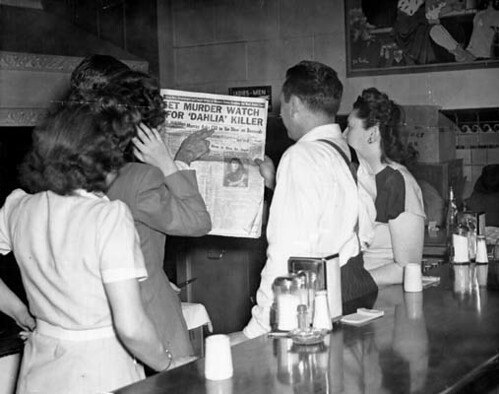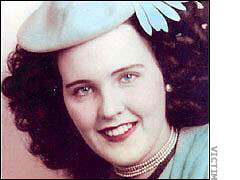
I’m pleased and proud to announce that a project on which I’ve been working for the past few months at the Los Angeles Police Museum has been completed and it opened to the public on Monday, March 19, 2012.
The project is an exhibit entitled ELIZABETH, and it is comprised of material used in the investigation of the most infamous unsolved homicide in Los Angeles’ history, the 1947 mutilation slaying of Elizabeth Short, The Black Dahlia.
 LAPD Chief, Charlie Beck, gave the Los Angeles Police Museum unprecedented access to the files in the 65 year old Black Dahlia case; and from those files we selected artifacts that represent the depth and breadth of the investigation mounted by the LAPD six decades ago.
LAPD Chief, Charlie Beck, gave the Los Angeles Police Museum unprecedented access to the files in the 65 year old Black Dahlia case; and from those files we selected artifacts that represent the depth and breadth of the investigation mounted by the LAPD six decades ago.

James Ellroy
The museum owes a debt to novelist James Ellroy, who has played a crucial role in getting previously unseen material in the Black Dahlia case to the public for this exhibit.
Being able to examine files kept by the detectives who originally investigated Elizabeth Short’s murder has been a phenomenal experience for me. Everything I saw and read made an impression on me, but it was the scope of the initial investigation that stunned me.
We identified 329 individual officers who knocked on the doors of well over 10,000 separate addresses that were scrupulously recorded! Failure to locate the crime scene and identify and apprehend the killer was never due to a lack of willingness on the part of the LAPD to allocate resources to the investigation. The manpower expended on the search for Short’s slayer was staggering.

View of a couple of the display cases for ELIZABETH
Among the items that we discovered in the files was an envelope filled with photographs of Elizabeth Short taken in Hollywood on a summer day in 1946, a few months before she was murdered. The photos were taken by a young man, a former soldier, she’d met while she was living in Long Beach. Beth and the young man spent a day in Hollywood seeing the sites and taking pictures.

Earl Carroll Theatre
In one of the photos Beth is posed beneath the marquee of the Earl Carroll Theater which declared “The Most Beautiful Girls in the World”. The young man was obviously smitten with Beth’s loveliness. Not all of the photos taken of Beth that day in Hollywood are on display at the museum; however, what’s there is a representative sample of what we discovered.
The photos wouldn’t come to the attention of the police until 1951 when the man was busted for beating his wife. In his statement to LAPD detectives he said that he and a friend, who had also known Elizabeth Short in Long Beach, had considered coming forward immediately following the news of her murder, but they’d decided not to get involved. The man may have been guilty of spousal battery, but he was eliminated as a suspect in Short’s murder.

Suspects & Confessors
And what, you may well ask, does the murder of the Black Dahlia have to do with vintage cosmetics ephemera?
As a tour guide for the Los Angeles based company ESOTOURIC, I have created a personality profile of Elizabeth Short based upon her make-up for THE REAL BLACK DAHLIA tour.
Yes indeed, when there is a way to combine my twin passions of historic Los Angeles crime with vintage cosmetics ephemera I’m all over it!
A few years ago I was rereading some of the original newspaper coverage of Short’s murder and I was intrigued by a comment made by one of her roommates, Linda Rohr.

Linda Rohr (seated), Marian Schmidt (standing)
Linda was one of the women with whom Beth Short shared an apartment on Cherokee near Hollywood Blvd. Rohr, a worker in the “Rouge Room” at Max Factor in Hollywood, stated that she was fascinated by the way in which Beth Short applied her make-up.

Dita Von Teese
According to Rohr, “She had pretty blue eyes but sometimes I think she overdid with make-up an inch thick.” She went on to describe Elizabeth Short’s finished look as startling and almost geisha-like.
Rohr’s description of Beth Short’s make-up caused me to wonder exactly what Beth was trying to accomplish with her look. During the post-war era women used make-up to enhance their natural beauty, not to alter it. Women such as actress Ingrid Bergman personified the ideal of natural beauty that was so popular at the time.
Beth Short lived decades too early for a Goth look, yet her reported penchant for make-up a shade or two lighter than her natural skin tone would give her more in common with Morticia, or Dita Von Teese, than with her contemporaries.
In my eyes the fact that Linda Rohr worked at Max Factor imbued her observations on Beth’s make-up with a degree of professional credibility – this was a woman who was familiar with current trends in cosmetics and their application.

Max Factor testing make-up
As a result of Linda’s description, I concluded that Beth was using her make-up as a mask, a way in which to keep people at arm’s length.
I don’t think that it was a conscious decision; I believe that without ever realizing it Beth created the character she would become in death, the Black Dahlia. And I also believe that her distinctive look played a crucial role in her abduction and subsequent slaying. I don’t mean to suggest that Elizabeth Short deserved her death, or that she brought it upon herself, only that her killer was drawn to her because she fulfilled the criteria for his (or her) perverse desires.
For more on my personality sketch of Elizabeth Short hop aboard Esotouric’s crime bus for the next THE REAL BLACK DAHLIA tour (April 14, 2012). This particular tour is always a sell out so purchase your ticket soon!
I highly recommend that you visit the Los Angeles Police Museum to see the Black Dahlia exhibit. The exhibit opened Monday, March 19, 2012 and will run through Saturday, June 16, 2012.











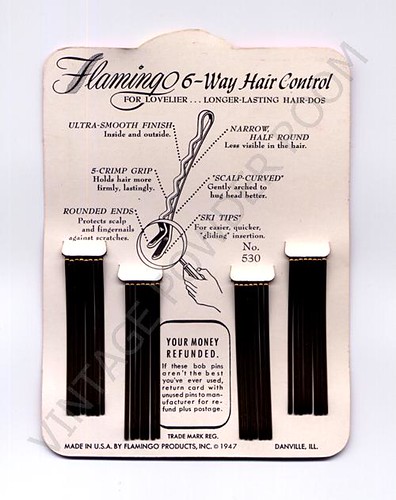
 Someone else may have thought of the lovely pink birds, but that’s just not how my mind works!
Someone else may have thought of the lovely pink birds, but that’s just not how my mind works!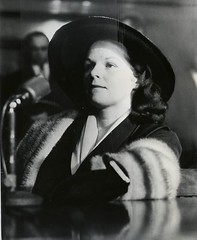
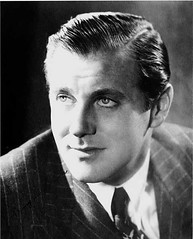
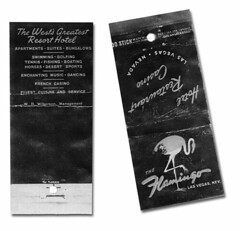
 Virginia was in Paris when she received the news of Ben’s death. It’s said that she fainted dead away. There would always be speculation about Virginia’s possible role in Ben’s assassination. But it’s highly unlikely that Virginia would have been tipped off about the plan to rub out Siegel, and even more doubtful that she’d have left one of her brothers in his company with the knowledge that a stray bullet could make him collateral damage.
Virginia was in Paris when she received the news of Ben’s death. It’s said that she fainted dead away. There would always be speculation about Virginia’s possible role in Ben’s assassination. But it’s highly unlikely that Virginia would have been tipped off about the plan to rub out Siegel, and even more doubtful that she’d have left one of her brothers in his company with the knowledge that a stray bullet could make him collateral damage.  Virginia would eventually settle in Europe with her third husband, a former Sun Valley ski instructor, Hans Hauser. She was trying to avoid the IRS, and probably some of her former mob acquaintances.
Virginia would eventually settle in Europe with her third husband, a former Sun Valley ski instructor, Hans Hauser. She was trying to avoid the IRS, and probably some of her former mob acquaintances. 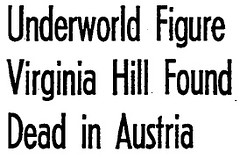
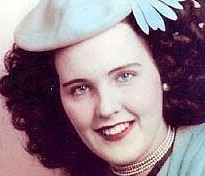 Oh, and before I forget – the last leap in my free association exercise led me to Elizabeth Short (aka the “Black Dahlia”). Her bisected body was discovered in a vacant lot in Leimert Park on January 15, 1947. Beth Short’s murder is arguably the most famous in Los Angeles’ history, and remains unsolved.
Oh, and before I forget – the last leap in my free association exercise led me to Elizabeth Short (aka the “Black Dahlia”). Her bisected body was discovered in a vacant lot in Leimert Park on January 15, 1947. Beth Short’s murder is arguably the most famous in Los Angeles’ history, and remains unsolved.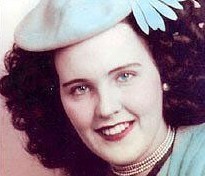
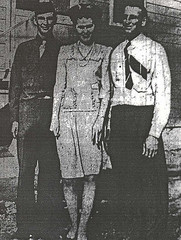
 Beth was one of thousands of young women who had flocked to Los Angeles during, and immediately following, WWII. There were good times to be had drinking and dancing with soliders, sailors and, Beth’s favorite, pilots. But the city was also a dark and dangerous place to be. Many of the former soliders returned to civilian life with demons that could not be vanquished with a bottle of beer or a spin on the dance floor with a lovely girl.
Beth was one of thousands of young women who had flocked to Los Angeles during, and immediately following, WWII. There were good times to be had drinking and dancing with soliders, sailors and, Beth’s favorite, pilots. But the city was also a dark and dangerous place to be. Many of the former soliders returned to civilian life with demons that could not be vanquished with a bottle of beer or a spin on the dance floor with a lovely girl.
 For more information and insights into Beth’s last couple of weeks in Los Angeles, including the REAL last place that she was seen alive (no, NOT the Biltmore Hotel) join me on
For more information and insights into Beth’s last couple of weeks in Los Angeles, including the REAL last place that she was seen alive (no, NOT the Biltmore Hotel) join me on 